Menopause and Sustainable Career Outcomes: A Science Mapping Approach
Abstract
1. Introduction
2. Theoretical Framework
3. Method
4. Performance Analysis of the Bibliometric Data
4.1. Published Articles and Citations Received
4.2. Most Productive Authors, Most Cited Publications and Most Prolific Journals
5. Science Mapping Analysis
5.1. Analyzing the Evolution of the Specific Research Themes for the Phenomenon of Menopause at the Workplace from a Sustainable Career Perspective
Evolution of the Scientific Domain
5.2. Analysis of the Scientific Domain in Each Sub-Period
5.2.1. Sub-Period 1992–2002
5.2.2. Sub-Period 2003–2013
5.2.3. Sub-Period 2014–2020
6. Conclusions, Limitations and Future Research Agenda
6.1. Reflecting upon the Outcomes
6.2. Limitations of This Study and Recommendations for Future Research
Author Contributions
Funding
Institutional Review Board Statement
Informed Consent Statement
Data Availability Statement
Conflicts of Interest
References
- Okeke, T.C.; Ezenyeaku, C.C.T.; Ikeako, L.G.; Agu, P.U. An overview of menopause associated Vaso Motor Symptoms and options available in its management. Niger. J. Med. 2013, 22, 7–14. [Google Scholar] [PubMed]
- Atkinson, C.; Beck, V.; Brewis, J.; Davies, A.; Duberley, J. Menopause and the Workplace: New Directions in HRM Research and HR Practice. Hum. Resour. Manag. J. 2020, 31, 49–64. [Google Scholar] [CrossRef]
- Thomas, F.; Renaud, F.; Beneiace, E.; De Mfeus, T. International Variability of Ages at Menarche and Meno-Pause: Patterns and Main Determinants. Hum. Biol. 2001, 73, 271–290. [Google Scholar] [CrossRef]
- Grandey, A.A.; Gabriel, A.S.; King, E.B. Tackling Taboo Topics: A Review of the Three M s in Working Women’s Lives. J. Manag. 2020, 46, 7–35. [Google Scholar] [CrossRef]
- Bariola, E.; Jack, G.; Pitts, M.; Riach, K.; Sarrel, P. Employment Conditions and Work-Related Stressors are Associated with Menopausal Symptom Reporting among Perimenopausal and Postmenopausal Women. Menopause 2017, 24, 247–251. [Google Scholar] [CrossRef]
- Hickey, M.; Riach, K.; Kachouie, R.; Jack, G. No Sweat: Managing Menopausal Symptoms at Work. J. Psychosom. Obstet. Gynecol. 2017, 38, 202–209. [Google Scholar] [CrossRef]
- Griffiths, A.; MacLennan, S.J.; Hassard, J. Menopause and Work: An Electronic Survey of Employees’ Attitudes in the UK. Maturitas 2013, 76, 155–159. [Google Scholar] [CrossRef]
- High, R.V.; Marcellino, P.A. Menopausal Women and the Work Environment. Soc. Behav. Personal. Int. J. 1994, 22, 347–354. [Google Scholar] [CrossRef]
- Steffan, B. Managing Menopause at Work: The Contradictory Nature of Identity Talk. Gend. Work. Organ. 2020, 28, 195–214. [Google Scholar] [CrossRef]
- De Vos, A.; Van der Heijden, B.I.J.M.; Akkermans, J. Sustainable Careers: Towards a Conceptual Model. J. Vocat. Behav. 2020, 117, 103196. [Google Scholar] [CrossRef]
- Van der Heijden, B.; De Vos, A.; Akkermans, J.; Spurk, D.; Semeijn, J.; Van der Velde, M.; Fugate, M. Special Issue Sustainable Careers across the Lifespan: Moving the Field Forward. Introductory Article. J. Vocat. Behav. 2020, 117, 103344. [Google Scholar] [CrossRef]
- Van der Heijden, B.I.J.M.; De Vos, A. (Eds.) Sustainable Careers: Introductory Chapter. In Handbook of Research on Sustainable Careers; Edward Elgar Publishing: Cheltenham, UK; Northampton, MA, USA, 2015; pp. 1–19. [Google Scholar]
- Catalyst. Quick Take: Women in the workforce—Global (October 31) 2018. Available online: http://www.catalyst.org/research/ (accessed on 17 November 2021).
- Jack, G.; Riach, K.; Bariola, E. Temporality and gendered agency: Menopausal subjectivities in women’s work. Hum. Relat. 2019, 72, 122–143. [Google Scholar] [CrossRef]
- Akinola, M. Measuring the Pulse of an Organization: Integrating Physiological Measures into the Organizational Scholar’s Toolbox. Res. Organ. Behav. 2010, 30, 203–223. [Google Scholar] [CrossRef]
- Ganster, D.C.; Rosen, C.C. Work Stress and Employee Health: A Multidisciplinary Review. J. Manag. 2013, 39, 1085–1122. [Google Scholar] [CrossRef]
- Van der Heijden, B.I.J.M. “No One Has Ever Promised You a Rose Garden” on Shared Responsibility and Employability En-Hancing Strategies throughout Careers; Open University of the Netherlands/Assen: Heerlen, The Netherlands, 2005. [Google Scholar]
- Marcus-Newhall, A.; Thompson, S.; Thomas, C. Examining a Gender Stereotype: Menopausal Women. J. Appl. Soc. Psychol. 2001, 31, 698–719. [Google Scholar] [CrossRef]
- Winakur, J. ‘Frankenfolks’ and the Rise of Ageism. Health Aff. 2011, 30, 995–996. [Google Scholar] [CrossRef]
- Jack, G.; Riach, K.; Bariola, E.; Pitts, M.; Schapper, J.; Sarrel, P. Menopause in the Workplace: What Employers Should Be Doing. Maturitas 2016, 85, 88–95. [Google Scholar] [CrossRef]
- Mvundura, V. Menopause Transition and Labor Market Outcomes. Dissertation Georgia State University. 2007. Available online: http://scholarworks.gsu.edu/econ_diss/38 (accessed on 17 November 2021).
- Monteleone, P.; Mascagni, G.; Giannini, A.; Genazzani, A.R.; Simoncini, T. Symptoms of Menopause—Global Prevalence, Physiology and Implications. Nat. Rev. Endocrinol. 2018, 14, 199–215. [Google Scholar] [CrossRef]
- Bromberger, J.T.; Kravitz, H.M.; Chang, Y.F.; Cyranowski, J.M.; Brown, C.; Matthews, K.A. Major depression during and after the menopausal transition: Study of Women’s Health Across the Nation (SWAN). Psychol. Med. 2011, 41, 1879–1888. [Google Scholar] [CrossRef]
- Small, H. Visualizing Science by Citation Mapping for Information Science. J. Am. Soc. 1999, 50, 799–813. [Google Scholar]
- Cobo, M.; López-Herrera, A.; Herrera-Viedma, E.; Herrera, F. Science Mapping Software Tools: Review, Analysis, and Cooperative Study Among Tools. J. Am. Soc. Inf. Sci. Technol. 2011, 62, 1382–1402. [Google Scholar] [CrossRef]
- Zupic, I.; Čater, T. Bibliometric Methods in Management and Organization. Organ. Res. Methods 2014, 18, 429–472. [Google Scholar] [CrossRef]
- Cobo, M.J.; López-Herrera, A.G.; Herrera-Viedma, E.; Herrera, F. SciMAT: A New Science Mapping Analysis Software Tool. J. Am. Soc. Inf. Sci. Technol. 2012, 63, 1609–1630. [Google Scholar] [CrossRef]
- Colakoglu, S.; Lepak, D.P.; Hong, Y. Measuring HRM Effectiveness: Considering Multiple Stakeholders in a Global Context. Hum. Resour. Manag. Rev. 2006, 16, 209–218. [Google Scholar] [CrossRef]
- Johns, G. The Essential Impact of Context on Organizational Behavior. Acad. Manag. Rev. 2006, 31, 386–408. [Google Scholar] [CrossRef]
- Rostosky, S.S.; Travis, C.B. Menopause Research and The Dominance of the Biomedical Model 1984–1994. Psychol. Women Q. 1996, 20, 285–312. [Google Scholar] [CrossRef]
- Hirschi, A.; Steiner, R.; Burmeister, A.; Johnston, C.S. A Whole-Life Perspective of Sustainable Careers: The Nature and Consequences of Nonwork Orientations. J. Vocat. Behav. 2020, 117, 103319. [Google Scholar] [CrossRef]
- Aguinis, H.; Pierce, C.A.; Bosco, F.A.; Muslin, I.S. First Decade of Organizational Research Methods: Trends in Design, Measurement, and Data-Analysis Topics. Organ. Res. Methods 2009, 12, 69–112. [Google Scholar] [CrossRef]
- Hood, W.W.; Wilson, C.S. The Literature of Bibliometrics, Scientometrics, and Informetrics. Scientometrics 2001, 52, 291. [Google Scholar] [CrossRef]
- Pritchard, A. Statistical Bibliography or Bibliometrics. J. Doc. 1969, 25, 348–349. [Google Scholar]
- Garfield, E. Is Citation Analysis a Legitimate Evaluation Tool? Scientometrics 1979, 1, 359–375. [Google Scholar] [CrossRef]
- Rosenthal, R. The File Drawer Problem and Tolerance for Null Results. Psychol. Bull. 1979, 86, 638–641. [Google Scholar] [CrossRef]
- Moral-Muñoz, J.A.; Herrera-Viedma, E.; Santisteban-Espejo, A.; Cobo, M.J. Software Tools for Conducting Bibliometric Analysis in Science: An Up-To-Date Review. Prof. Inf. 2020, 29, e290103. [Google Scholar] [CrossRef]
- Börner, K.; Chen, C.; Boyack, K.W. Visualizing Knowledge Domains. Annu. Rev. Inf. Sci. Technol. 2005, 37, 179–255. [Google Scholar] [CrossRef]
- Falagas, M.E.; Pitsouni, E.I.; Malietzis, G.A.; Pappas, G. Comparison of PubMed, Scopus, Web of Science, and Google Scholar: Strengths and Weaknesses. FASEB J. 2008, 22, 338–342. [Google Scholar] [CrossRef] [PubMed]
- Martínez, M.A.; Cobo, M.J.; Herrera, M.; Herrera-Viedma, E. Analyzing the Scientific Evolution of Social Work Using Science Mapping. Res. Soc. Work Pract. 2015, 25, 257–277. [Google Scholar] [CrossRef]
- Callon, M.; Courtial, J.-P.; Turner, W.A.; Bauin, S. From Translations to Problematic Networks: An Introduction to Co-Word Analysis. Soc. Sci. Inf. 1983, 22, 191–235. [Google Scholar] [CrossRef]
- Coulter, N.; Monarch, I.; Konda, S. Software Engineering as Seen Through its Research Literature: A Study in Co-Word Analysis. J. Am. Soc. Inf. Sci. 1998, 49, 1206–1223. [Google Scholar] [CrossRef]
- Callon, M.; Courtial, J.P.; Laville, F. Co-Word Analysis as a Tool for Describing the Network of Interactions Between Basic and Technological Research: The Case of Polymer Chemsitry. Scientometrics 1991, 22, 155–205. [Google Scholar] [CrossRef]
- Gold, E.B.; Bromberger, J.; Crawford, S.; Samuels, S.; Greendale, G.A.; Harlow, S.D.; Skurnick, J. Factors Associated with Age at Natural Menopause in a Multiethnic Sample of Midlife Women. Am. J. Epidemiol. 2001, 153, 865–874. [Google Scholar] [CrossRef]
- Duijts, S.F.A.; Van Egmond, M.P.; Spelten, E.; Van Muijen, P.; Anema, J.R.; Van Der Beek, A.J. Physical and Psychosocial Problems in Cancer Survivors Beyond Return to Work: A Systematic Review. Psycho-Oncology 2014, 23, 481–492. [Google Scholar] [CrossRef]
- Bebbington, P.E.; Dunn, G.; Jenkins, R.; Lewis, G.; Brugha, T.; Farrell, M.; Meltzer, H. The Influence of Age and Sex on the Prevalence of Depressive Conditions: Report from the National Survey of Psychiatric Morbidity. Psychol. Med. 1998, 28, 9–19. [Google Scholar] [CrossRef]
- Chirawatkul, S.; Manderson, L. Perceptions of Menopause in Northeast Thailand: Contested Meaning and Practice. Soc. Sci. Med. 1994, 39, 1545–1554. [Google Scholar] [CrossRef]
- Green, E.E.; Thompson, D.; Griffiths, F. Narratives of Risk: Women at Midlife, Medical ‘experts’ and Health Technologies. Health Risk Soc. 2002, 4, 273–286. [Google Scholar] [CrossRef]
- Hunter, M.S.; O’Dea, I.; Britten, N. Decision-Making and Hormone Replacement Therapy: A Qualitative Analysis. Soc. Sci. Med. 1997, 45, 1541–1548. [Google Scholar] [CrossRef]
- Davis, M.C.; Matthews, K.A.; Meilahn, E.N.; Kiss, J.E. Are Job Characteristics Related to Fibrinogen Levels in Middle-Aged Women? Health Psychol. 1995, 14, 310–318. [Google Scholar] [CrossRef] [PubMed]
- Wamala, S.P.; Wolk, A.; Schenck-Gustafsson, K.; Orth-Gomer, K. Lipid Profile and Socioeconomic Status in Healthy Middle Aged Women in Sweden. J. Epidemiol. Community Health 1997, 51, 400–407. [Google Scholar] [CrossRef] [PubMed]
- Gardner, K.M.; Shu, X.O.; Jin, F.; Dai, Q.; Ruan, Z.; Thompson, S.J.; Hussey, J.R.; Gao, Y.T.; Zheng, W. Occupations and Breast Cancer Risk among Chinese Women in Urban Shanghai. Am. J. Ind. Med. 2002, 42, 296–308. [Google Scholar] [CrossRef] [PubMed]
- Kleinman, N.L.; Rohrbacker, N.J.; Bushmakin, A.G.; Whiteley, J.; Lynch, W.D.; Shah, S.N. Direct and Indirect Costs of Women Diagnosed with Menopause Symptoms. J. Occup. Environ. Med. 2013, 55, 465–470. [Google Scholar] [CrossRef]
- Popovic, M.; McNeill, F.E.; Chettle, D.R.; Webber, C.E.; Lee, C.V.; Kaye, W.E. Impact of Occupational Exposure on Lead Levels in Women. Environ. Health Perspect. 2005, 113, 478–484. [Google Scholar] [CrossRef]
- Bloom, J.R.; Stewart, S.; Chang, S.; Banks, P.J. Then and Now: Quality of Life of Young Breast Cancer Survivors. Psycho-Oncology 2004, 13, 147–160. [Google Scholar] [CrossRef] [PubMed]
- Outram, S.; Mishra, G.D.; Schofield, M.J. Sociodemographic and Health Related Factors Associated with Poor Mental Health in midlife Australian Women. Women Health 2004, 39, 97–115. [Google Scholar] [CrossRef] [PubMed]
- Cassou, B.; Mandereau, L.; Aegerter, P.; Touranchet, A.; Derriennic, F. Work-related Factors Associated with Age at Natural Menopause in a Generation of French Gainfully Employed Women. Am. J. Epidemiol. 2007, 166, 429–438. [Google Scholar] [CrossRef] [PubMed]
- Fallahzadeh, H. Quality of Life after the Menopause in Iran: A Population Study. Qual. Life Res. 2010, 19, 813–819. [Google Scholar] [CrossRef]
- Sasser, A.C.; Rousculp, M.D.; Birnbaum, H.G.; Oster, E.F.; Lufkin, E.; Mallet, D. Economic Burden of Osteoporosis, Breast Cancer, and Cardiovascular Disease among Postmenopausal Women in an Employed Population. Women’s Health Issues 2005, 15, 97–108. [Google Scholar] [CrossRef]
- Hauptmann, M.; Mohan, A.K.; Doody, M.M.; Linet, M.S.; Mabuchi, K. Mortality from Diseases of the Circulatory System in Radiologic Technologists in the United States. Am. J. Epidemiol. 2003, 157, 239–248. [Google Scholar] [CrossRef] [PubMed]
- Wang, X.-S.; Travis, R.C.; Reeves, G.; Green, J.; Allen, E.N.; Key, T.J.; Roddam, A.W.; Beral, V. Characteristics of the Million Women Study Participants Who Have and Have Not Worked at Night. Scand. J. Work. Environ. Health 2012, 38, 590–599. [Google Scholar] [CrossRef]
- Bien, A.; Rzonca, E.; Iwanowicz-Palus, G.; Pańczyk-Szeptuch, M. The Influence of Climacteric Symptoms on Women’s Lives and Activities. Int. J. Environ. Res. Public Health 2015, 12, 3835–3846. [Google Scholar] [CrossRef] [PubMed]
- Ghorbani, R.; Nassaji, M.; Shahbazi, A.; Rostami, B.; Taheri, M. Association between Quality of Life, Menopausal Status, and Sociodemographic Factors among Middle-Aged Women in Iran. J. Egypt. Public Health Assoc. 2015, 90, 166–170. [Google Scholar] [CrossRef]
- Converso, D.; Viotti, S.; Sottimano, I.; Loera, B.; Molinengo, G.; Guidetti, G. The Relationship between Menopausal Symptoms and Burnout. A Cross-Sectional Study among Nurses. BMC Women’s Health 2019, 19, 1–12. [Google Scholar] [CrossRef] [PubMed]
- Raczkiewicz, D.; Owoc, A.; Sarecka-Hujar, B.; Saran, T.; Bojar, I. Impact of Spinal Pain on Daily Living Activities in Post-Menopausal Women Working in Agriculture. Ann. Agric. Environ. Med. 2017, 24, 134–140. [Google Scholar] [CrossRef]
- Rutanen, R.; Nygård, C.-H.; Moilanen, J.; Mikkola, T.; Raitanen, J.; Tomas, E.; Luoto, R. Effect of Physical Exercise on Work Ability and Daily Strain in Symptomatic Menopausal Women: A Randomized Controlled Trial. Work 2014, 47, 281–286. [Google Scholar] [CrossRef] [PubMed]
- Verburgh, M.; Verdonk, P.; Appelman, Y.; Zanten, M.B.-V.; Nieuwenhuijsen, K. “I Get That Spirit in Me”—Mentally Empowering Workplace Health Promotion for Female Workers in Low-Paid Jobs During Menopause and Midlife. Int. J. Environ. Res. Public Health 2020, 17, 6462. [Google Scholar] [CrossRef] [PubMed]
- Wieder-Huszla, S.; Szkup, M.; Jurczak, A.; Samochowiec, A.; Samochowiec, J.; Stanisławska, M.; Rotter, I.; Karakiewicz, B.; Grochans, E. Effects of Socio-Demographic, Personality and Medical Factors on Quality of Life of Postmenopausal Women. Int. J. Environ. Res. Public Health 2014, 11, 6692–6708. [Google Scholar] [CrossRef] [PubMed]
- Abdelrahman, R.Y.; Abushaikha, L.A.; al-Motlaq, M.A. Predictors of Psychological Well-Being and Stress among Jordanian Menopausal Women. Qual. Life Res. 2014, 23, 167–173. [Google Scholar] [CrossRef]
- Watkins, E.R.; Walker, A.; Mol, E.; Jahnke, S.; Richardson, A.J. Women Firefighters’ Health and Well-Being: An International Survey. Women’s Health Issues 2019, 29, 424–431. [Google Scholar] [CrossRef]
- Grochans, E.; Szkup, M.; Kotwas, A.; Kopeć, J.; Karakiewicz, B.; Jurczak, A. Analysis of Sociodemographic, Psychological, and Genetic Factors Contributing to Depressive Symptoms in Pre-, Peri-and Postmenopausal Women. Int. J. Environ. Res. Public Health 2018, 15, 712. [Google Scholar] [CrossRef]
- Moen, P. A Life Course Perspective on Retirement, Gender, and Well-Being. J. Occup. Health Psychol. 1996, 1, 131–144. [Google Scholar] [CrossRef]
- Roberts, B.W.; Friend, W. Career Momentum in Midlife Women: Life Context, Identity, and Personality Correlates. J. Occup. Health Psychol. 1998, 3, 195–208. [Google Scholar] [CrossRef]
- Barley, S.R.; Bechky, B.A.; Milliken, F.J. The Changing Nature of Work: Careers, Identities, and Work Lives in the 21stCentury. Acad. Manag. Discov. 2017, 3, 111–115. [Google Scholar] [CrossRef]
- Kooij, D.T.A.M.; Jansen, P.G.W.; Dikkers, J.S.E.; De Lange, A.H. The Influence of Age on the Associations between HR Practices and both Affective Commitment and Job Satisfaction: A Meta-Analysis. J. Organ. Behav. 2010, 31, 1111–1136. [Google Scholar] [CrossRef]
- Veth, K.N.; Korzilius, H.P.L.M.; Van Der Heijden, B.I.J.M.; Emans, B.J.M.; De Lange, A.H. Which HRM Practices Enhance Employee Outcomes at Work Across the Life-Span? Int. J. Hum. Resour. Manag. 2019, 30, 2777–2808. [Google Scholar] [CrossRef]
- De Jonge, J.; Dormann, C. Stressors, Resources, and Strain at Work: A Longitudinal Test of the Triple-Match Principle. J. Appl. Psychol. 2006, 91, 1359–1374. [Google Scholar] [CrossRef] [PubMed]
- Martin, M.; Hofer, S.M. Intraindividual Variability, Change, and Aging: Conceptual and Analytical Issues. Gerontology 2004, 50, 7–11. [Google Scholar] [CrossRef] [PubMed]
- Cole, E.R. Intersectionality and Research in Psychology. Am. Psychol. 2009, 64, 170–180. [Google Scholar] [CrossRef]
- Podsakoff, P.M.; MacKenzie, S.B.; Lee, J.Y.; Podsakoff, N.P. Common Method Biases in Behavioral Research: A Critical Review of the Literature and Recommended Remedies. J. Appl. Psychol. 2003, 88, 879–903. [Google Scholar] [CrossRef] [PubMed]
- Laberge, M.; Ledoux, E. Occupational Health and Safety Issues Affecting Young Workers: A Literature Review. Work 2011, 39, 215–232. [Google Scholar] [CrossRef] [PubMed]
- Frese, M.; Zapf, D. Methodological Issues in the Study of Work Stress: Objective vs Subjective Measurement of Work Stress and the Question of Longitudinal Studies. In Causes, Coping and Consequences of Stress at Work; Cooper, C.L., Payne, R., Eds.; John Wiley & Sons Ltd.: Chichester, UK, 1988; pp. 375–411. [Google Scholar]
- Peters, P.; Van der Heijden, B.I.J.M.; Spurk, D.; De Vos, A.; Klaassen, R. Please Don’t Look at Me That Way. An Empirical Study into the Effects of Age-Based (Meta-) Stereotyping on Employability Enhancement among Older Supermarket Workers. Front. Psychol. 2019, 10, 249. [Google Scholar] [CrossRef] [PubMed]
- Van Engen, M.L.; Vinkenburg, C.; Dikkers, J.S.E. Sustainability in Combining Career and Care: Challenging Normative Beliefs about Parenting. J. Soc. Issues 2012, 68, 645–664. [Google Scholar] [CrossRef]
- Ackerman, P.L.; Kanfer, R. Work in the 21st Century: New Directions for Aging and Adult Development. Am. Psychol. 2020, 75, 486–498. [Google Scholar] [CrossRef]
- Nelson, H.D.; Haney, E.; Humphrey, L.; Miller, J.; Nedrow, A.; Nicolaidis, C.; Vesco, K.; Walker, M.; Bougatsos, C.; Nygren, P. Management of Menopause-Related Symptoms. In Summary, Evidence Report/Technology Assessment No. 120; (Prepared by the Oregon Evidence-based Practice Center, under Contract No. 290-02-0024.); AHRQ Publication No. 05-E016-1; Agency for Healthcare Research and Quality: Rockville, MD, USA, 2005. [Google Scholar]


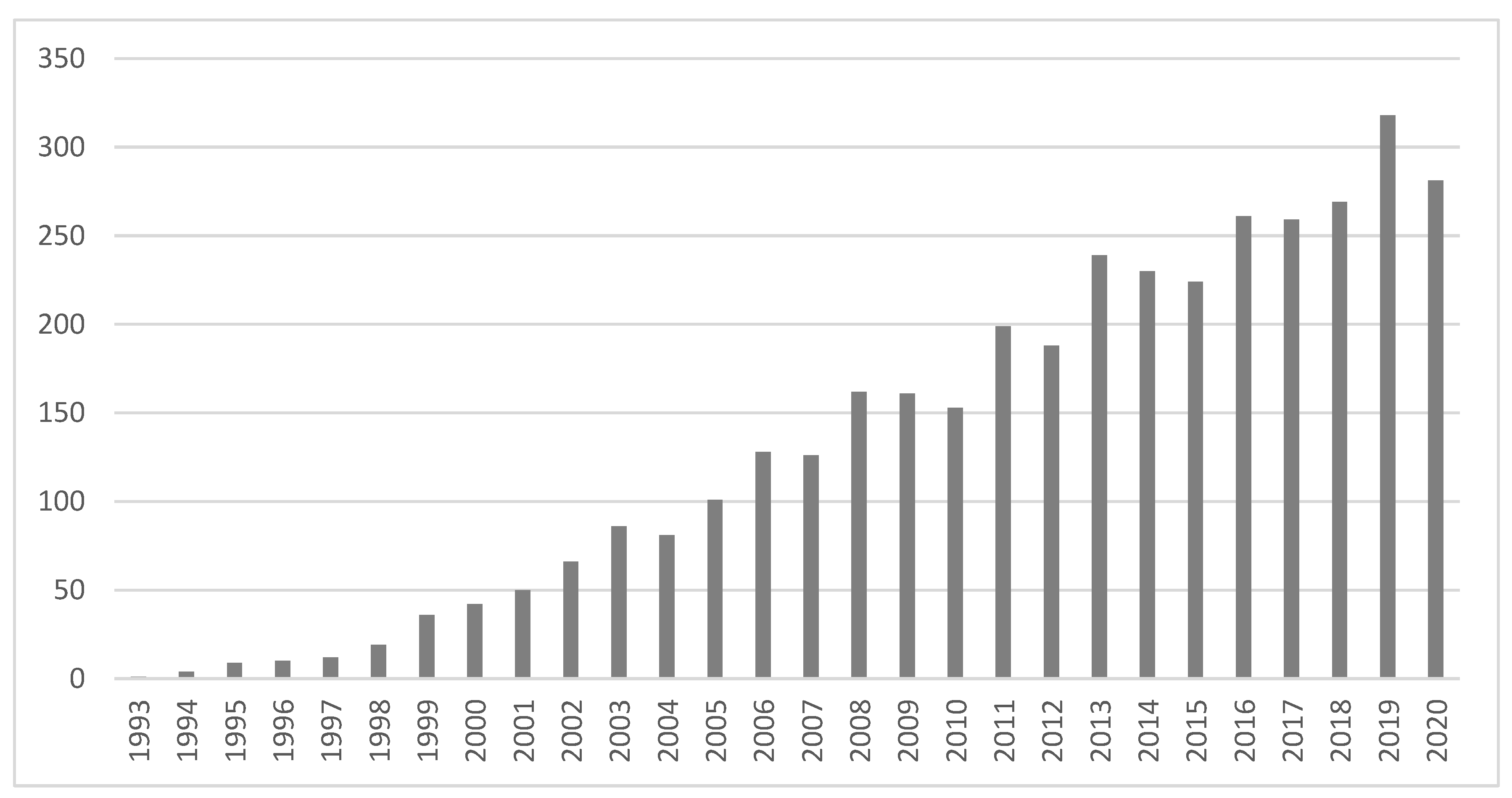

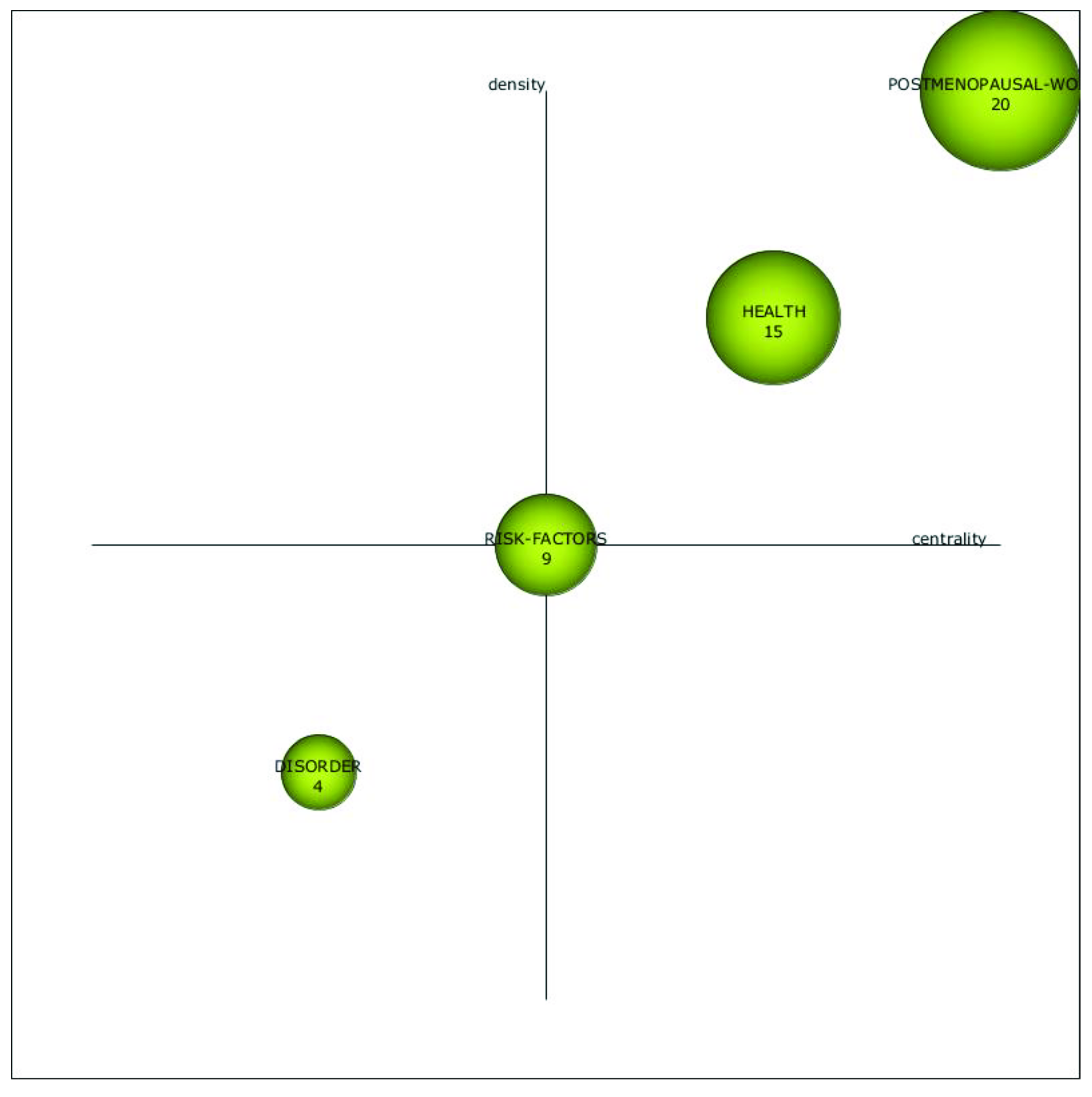
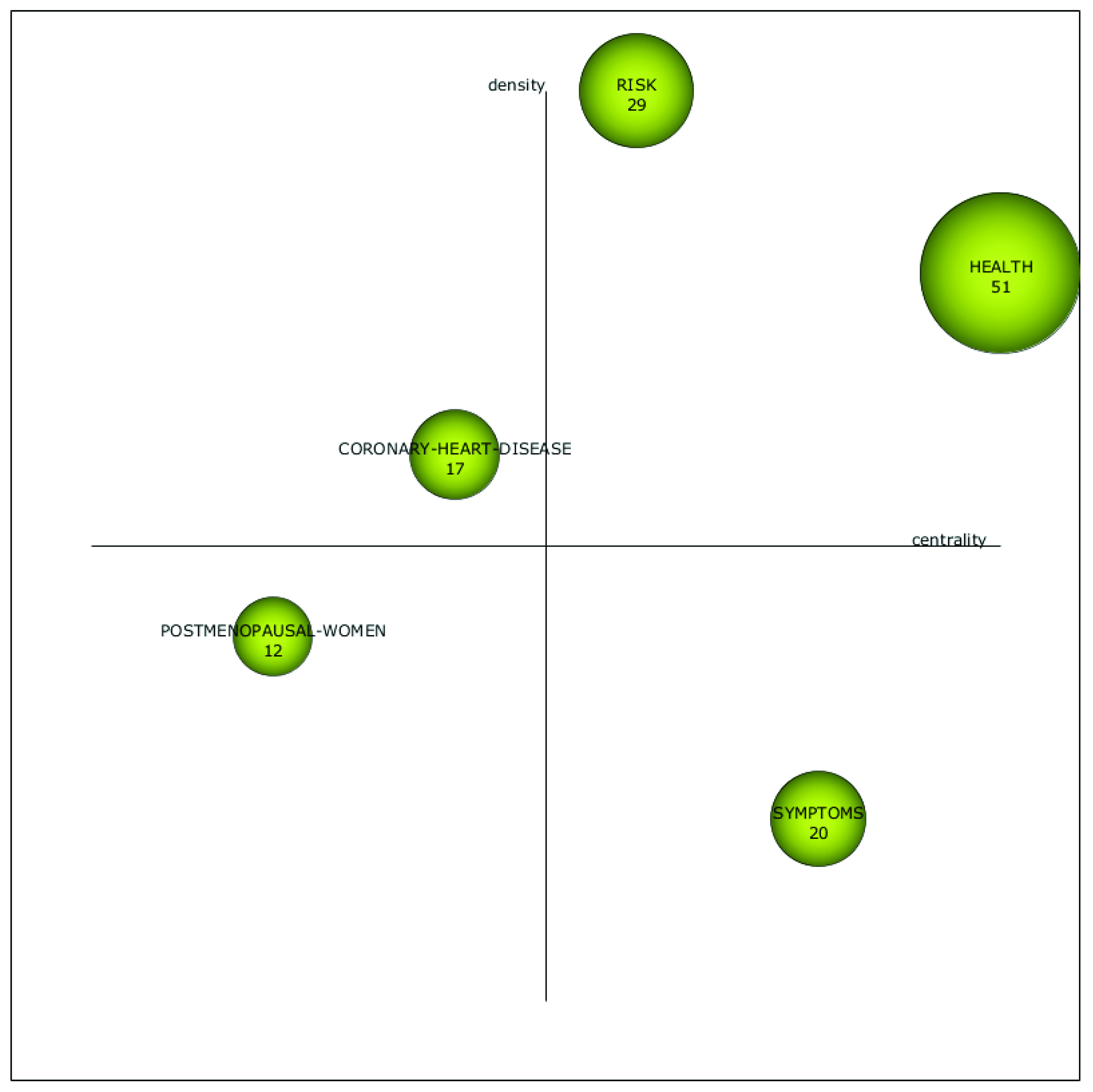
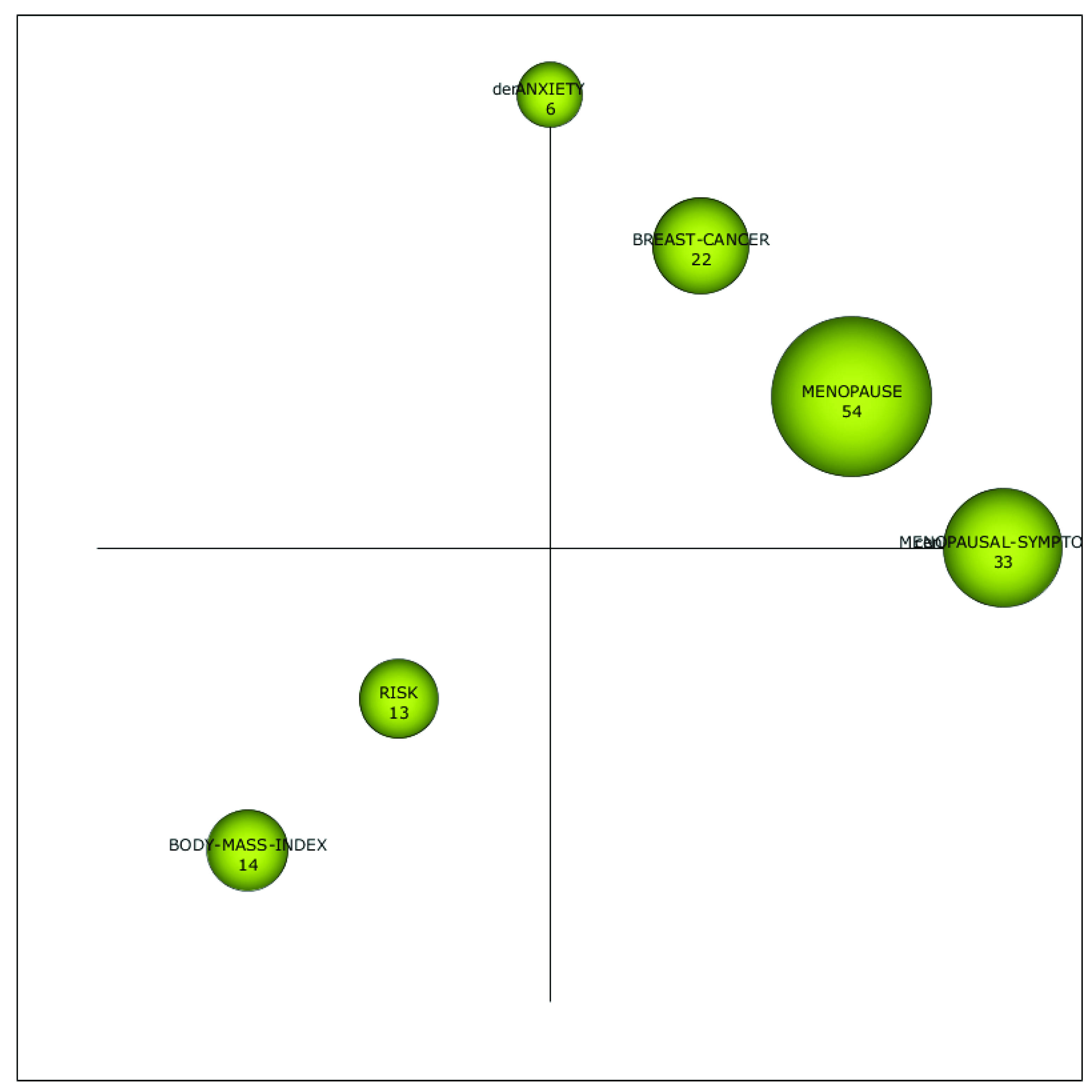
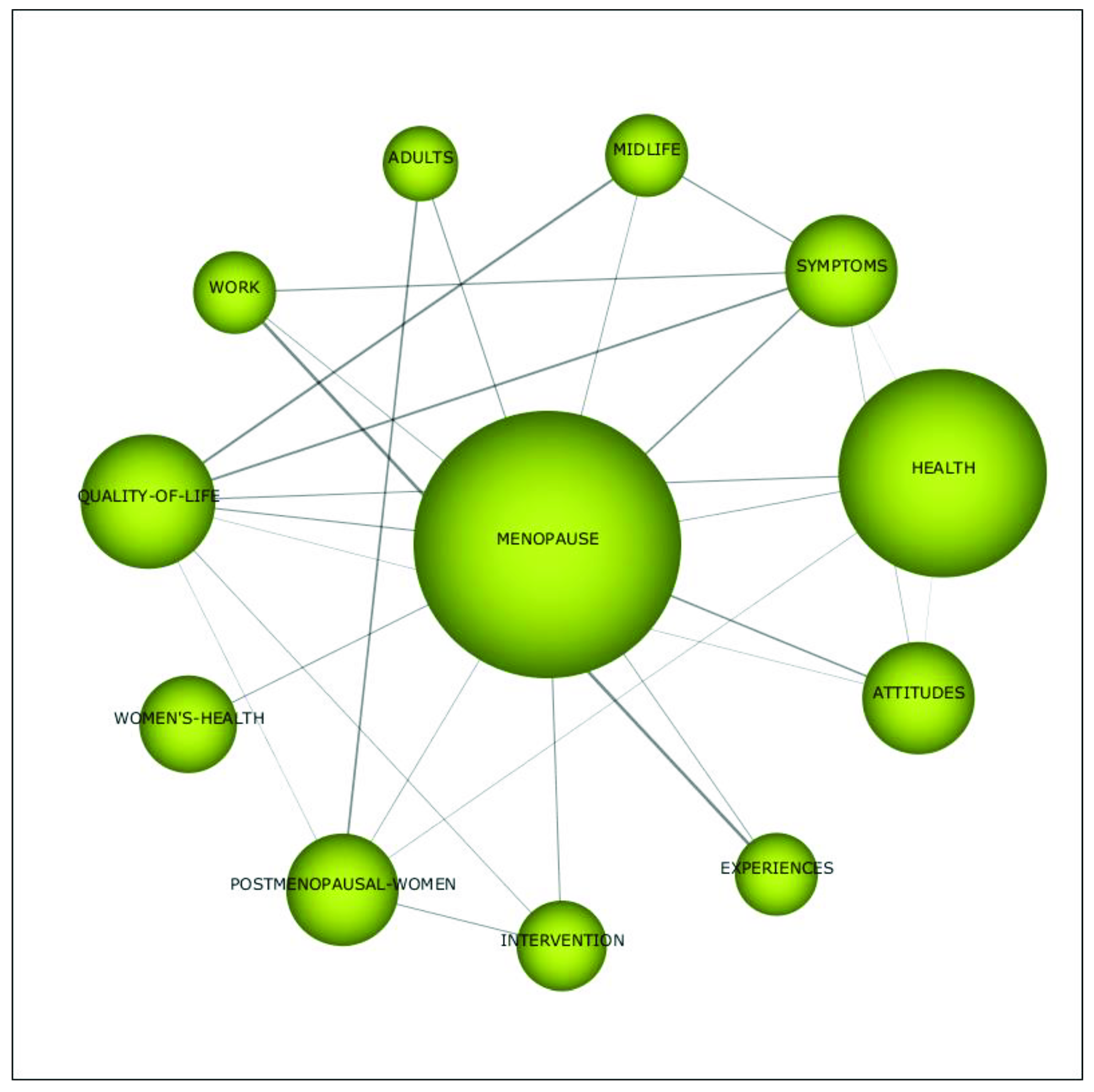

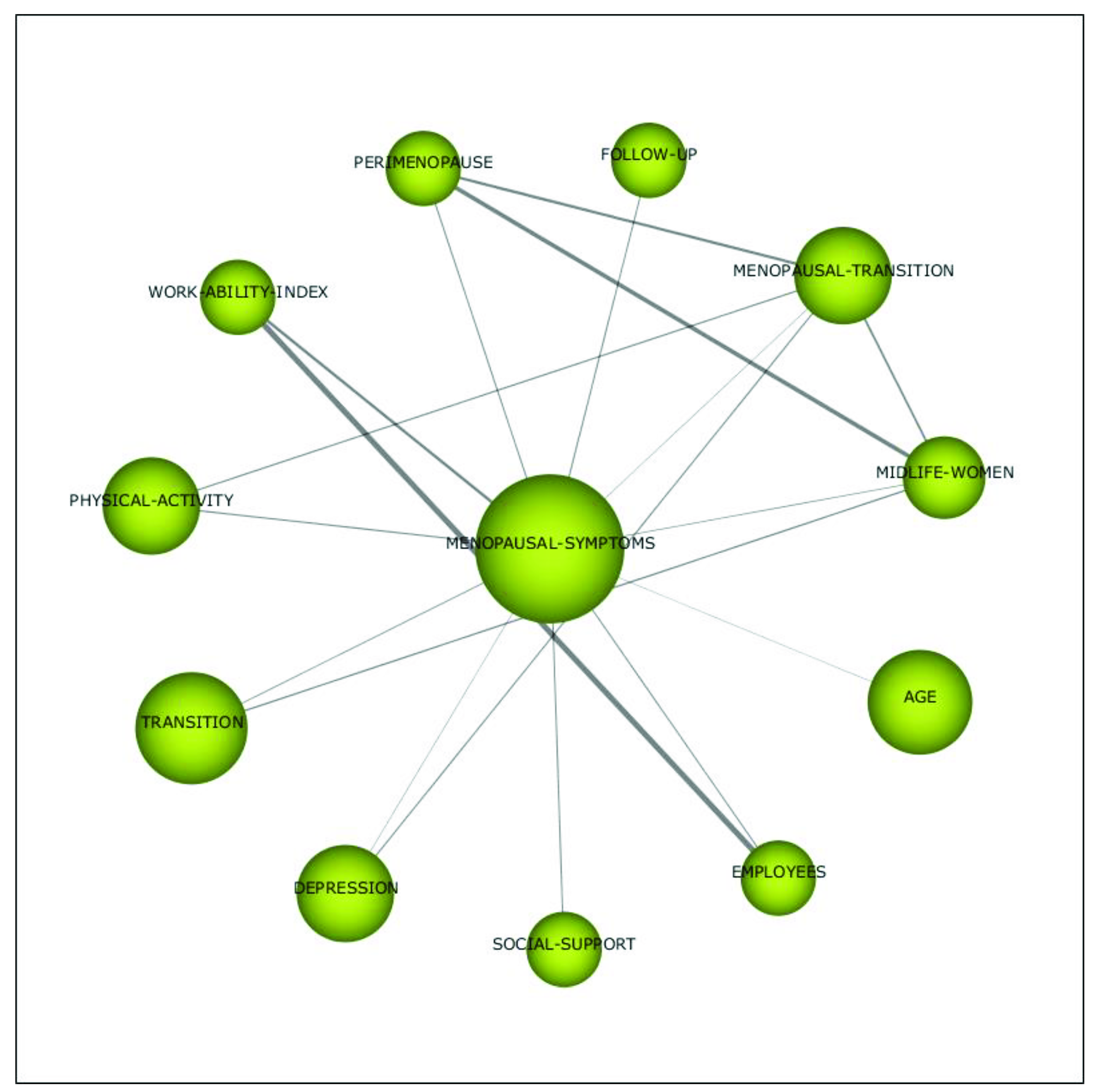
| TS = ((Job* or career* or employment* or employee* or professional* or “work-related health” or “work ability” or “ability to work” or “work outcome*” or “experience of work” or burnout or vitality or “work engagement” or “motivation at work” or “motivation to work” or “motivation to continue working” or “work centrality” or “job satisfaction” or “job performance” or employability) and (menopau* or climacteric* or amenorrhoea or amenorroe)) |
| Author | Documents |
|---|---|
| Raczkiewicz, D.; Bojar, I. | 4 |
| Kingsberg, S.A.; Simon, J.A.; Hirokawa, K.; Humeniuk, E.; Grochans, E.; Szkup, M.; Karakiewicz, B.; Jurczak, A.; Lope, V.; Garcia-Perez, J.; Perez-Gomez, B.; Angel Alba, M.; van der Haar, Rudolf; Pedraz-Pingarron, C.; Moreo, P.; Santamarina, C.; Ederra, M.; Salas-Trejo, D.; Sanchez-Contador, C.; Llobet, R.; Pollan, M.; Owoc, A.; Ghorbani, R.; Nassaji, M.; Shahbazi, A.; Bien, A.; Rutanen, R.; Luoto, R.; Tomas, E.; Nygard, C.; Willett, W.C.; Boughton, M.; Brown, D.E.; Brown, D.E; Ariyoshi, H.; Gold, EB; Derry, PS; Mansfield, PK; Koch, PB; Matthews, KA; Bromberger, J; Wilbur, J | 2 |
| Title | Author/s | Year | Citations | |
|---|---|---|---|---|
| 1 | Factors associated with age at natural menopause in a multiethnic sample of midlife women | Gold, EB, Bromberger, J, Crawford, S, Samuels, S, Greendale, GA, Harlow, SD, Skurnick, J | 2001 | 488 |
| 2 | Then and now: Quality of life of young breast cancer survivors | Bloom, JR, Stewart, SL, Chang, S, Banks, PJ | 2004 | 259 |
| 3 | The influence of age and sex on the prevalence of depressive conditions: report from the National Survey of Psychiatric Morbidity | Bebbington, PE, Dunn, G, Jenkins, R, Lewis, G, Brugha, T, Farrell, M, Meltzer, H | 1998 | 217 |
| 4 | Physical and psychosocial problems in cancer survivors beyond return to work: a systematic review | Duijts, SFA, Van Egmond, MP, Spelten, E, Van Muijen, P, Anema, JR, Van der Beek, AJ | 2014 | 139 |
| 5 | Health-related quality of life in a multiethnic sample of middle-aged women—Study of Women’s Health Across the Nation (SWAN) | Avis, NE, Ory, M, Matthews, KA, Schocken, M, Bromberger, J, Colvin, A | 2003 | 115 |
| 6 | Reproductive history and mortality in late middle age among Norwegian men and women | Grundy, E, Kravdal, O | 2008 | 96 |
| 7 | gender inequalities in health— social position, affective-disorders and minor physical morbidity | Popay, J, Bartley, M, Owen, C | 1993 | 91 |
| 8 | Mortality from diseases of the circulatory system in radiologic technologists in the United States | Hauptmann, M, Mohan, AK, Doody, MM, Linet, MS, Mabuchi, K | 2003 | 62 |
| 9 | Decision-making and hormone replacement therapy: A qualitative analysis | Hunter, MS, ODea, I, Britten, N | 1997 | 62 |
| 10 | Impact of occupational exposure on lead levels in women | Popovic, M, McNeill, FE, Chettle, DR, Webber, CE, Lee, CV, Kaye, WE | 2005 | 59 |
| 11 | Evaluation of a group cognitive behavioural intervention for women suffering from menopausal symptoms following breast cancer treatment | Hunter, MS, Coventry, S, Hamed, H, Fentiman, I, Grunfeld, EA | 2009 | 58 |
| 12 | A survey on issues in the lives of women with severe mental illness | Ritsher, JEB, Coursey, RD, Farrell, EW | 1997 | 58 |
| 13 | Economic burden of osteoporosis, breast cancer, and cardiovascular disease among postmenopausal women in an employed population | Sasser, AC, Rousculp, MD, Birnbaum, HG, Oster, EF, Lufkin, E, Mallet, D | 2005 | 57 |
| 14 | Lactation in relation to postmenopausal breast cancer | Newcomb, PA, Egan, KM, Titus-Ernstoff, L, Trentham-Dietz, A, Greenberg, ER, Baron, JA, Willett, WC, Stampfer, MJ | 1999 | 55 |
| Journals | Documents | |
|---|---|---|
| 1 | BMC WOMENS HEALTH | 10 |
| 2 | INTERNATIONAL JOURNAL OF ENVIRONMENTAL RESEARCH AND PUBLIC HEALTH | 10 |
| 3 | JOURNAL OF WOMENS HEALTH | 10 |
| 4 | AMERICAN JOURNAL OF EPIDEMIOLOGY | 8 |
| 5 | WOMENS HEALTH ISSUES | 7 |
| 6 | WOMEN & HEALTH | 7 |
| 7 | SOCIAL SCIENCE & MEDICINE | 6 |
| 8 | ANNALS OF AGRICULTURAL AND ENVIRONMENTAL MEDICINE | 5 |
| 9 | HEALTH CARE FOR WOMEN INTERNATIONAL | 5 |
| 10 | JOURNAL OF OCCUPATIONAL AND ENVIRONMENTAL MEDICINE | 5 |
| 11 | BMC PUBLIC HEALTH | 4 |
| 12 | WORK-A JOURNAL OF PREVENTION ASSESSMENT & REHABILITATION | 4 |
| 13 | PSYCHO-ONCOLOGY | 4 |
| 14 | JOURNAL OF WOMENS HEALTH & GENDER-BASED MEDICINE | 4 |
Publisher’s Note: MDPI stays neutral with regard to jurisdictional claims in published maps and institutional affiliations. |
© 2021 by the authors. Licensee MDPI, Basel, Switzerland. This article is an open access article distributed under the terms and conditions of the Creative Commons Attribution (CC BY) license (https://creativecommons.org/licenses/by/4.0/).
Share and Cite
Van der Heijden, B.I.J.M.; Pak, K.; Santana, M. Menopause and Sustainable Career Outcomes: A Science Mapping Approach. Int. J. Environ. Res. Public Health 2021, 18, 12559. https://doi.org/10.3390/ijerph182312559
Van der Heijden BIJM, Pak K, Santana M. Menopause and Sustainable Career Outcomes: A Science Mapping Approach. International Journal of Environmental Research and Public Health. 2021; 18(23):12559. https://doi.org/10.3390/ijerph182312559
Chicago/Turabian StyleVan der Heijden, Beatrice I. J. M., Karen Pak, and Mónica Santana. 2021. "Menopause and Sustainable Career Outcomes: A Science Mapping Approach" International Journal of Environmental Research and Public Health 18, no. 23: 12559. https://doi.org/10.3390/ijerph182312559
APA StyleVan der Heijden, B. I. J. M., Pak, K., & Santana, M. (2021). Menopause and Sustainable Career Outcomes: A Science Mapping Approach. International Journal of Environmental Research and Public Health, 18(23), 12559. https://doi.org/10.3390/ijerph182312559





